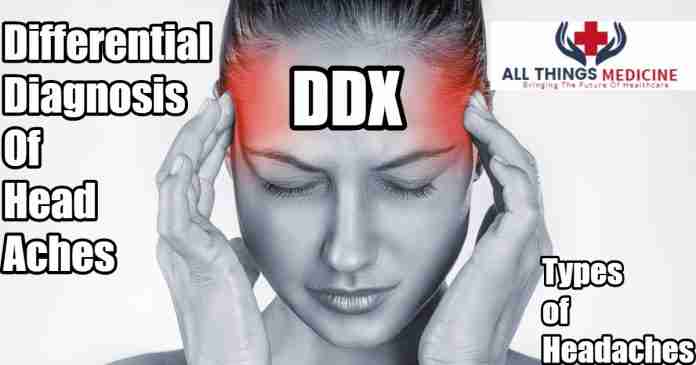Page Contents
Definition
Headache: A pain in the head with the pain being above the eyes or the ears, behind the head (occipital), or in the back of the upper neck. A headache, like a chest pain or back ache, has many causes. This Article will discuss the differential diagnosis of headaches, types of headaches, and when you should be really concerned about your headache.
All headaches are considered primary headaches or secondary headaches. Primary headaches are not associated with other diseases. Examples of primary headaches are migraine headaches, tension headaches, and cluster headaches. Secondary headaches are caused by other diseases. The associated disease may be minor or major.
Tension headaches are the most common type of primary headaches. As many as 90% of adults have tension headaches. Tension headaches are more common among women than men.
Migraine headaches are the second most common type of primary headaches. An estimated 28 million people in the US have migraine headaches. Migraine headaches affect children as well as adults. Before puberty, boys and girls are affected equally by migraine headaches, but after puberty more women than men have them. A migraine often goes undiagnosed or is misdiagnosed as tension or sinus headaches.
Cluster headaches are rare but important types of primary headaches, affecting mainly men. The average age of cluster headache sufferers is 28-30 years, although headaches may begin in childhood.
Secondary headaches may result from innumerable conditions, ranging from life-threatening ones such as brain tumors, strokes, meningitis, and subarachnoid hemorrhages to less serious but common conditions such as withdrawal from caffeine and discontinuation of analgesics (painkilling medication). Many people suffer from “mixed” headache disorders in which tension headaches or secondary headaches may trigger a migraine.
All these types make it essential to form a differential diagnosis of headaches.
The treatment of a headache depends on the type and severity of the headache and on other factors such as the age of the patient.
A headache is also referred to as cephalgia.
Major Types
All headaches are considered primary headaches or secondary headaches. Primary headaches are not associated with other diseases. Examples of primary headaches are migraine headaches, tension headaches, and cluster headaches. Secondary headaches are caused by other diseases. The associated disease may be minor or major.
The different types of headaches depend upon the class to which they belong. These will help in understanding the differential diagnosis of headaches, Some common types include:
- Primary tension headaches that are episodic
- Primary tension headaches that are chronic
- Primary muscle contraction headaches
- Primary migraine headaches with aura
- Primary migraine headaches without aura
- Primary cluster headache
- Primary paroxysmal hemicrania (a type of a cluster headache)
- Primary cough headache
- Primary stabbing headache
- Primary headache associated with sexual intercourse
- Primary thunderclap headache
- Hypnic headache (headaches that awaken a person from sleep)
- Hemicrania continua (headaches that are persistently on one side only. right or left [unilateral])
- New daily-persistent headache (NDPH) (a type of chronic headache)
- Headache from exertion
- Trigeminal neuralgia and other cranial nerve inflammation
- Secondary headaches due to:
-
- Trauma
- Disorders
- Infection
- Structural problems with the bones of the face, teeth, eyes, ears, nose, sinuses or other structures
- Substance abuse or withdrawal
-
you may also be interested in some of these other articles below
A patient should seek medical care if their headache is:
- The “worst headache of your life.” This is the wording often used in textbooks as a cue for medical practitioners to consider the diagnosis of a subarachnoid hemorrhage due to a ruptured cerebral aneurysm. The amount of pain will often be taken in context with the appearance of the patient and other associated signs and symptoms. Too often, patients are prompted to use this expression by a health-care professional and do not routinely volunteer the phrase.
- Different than their usual headaches
- Starts suddenly or is aggravated by exertion, coughing, bending over, or sexual activity
- Associated with persistent nausea and vomiting
- Associated with fever or stiff neck. A stiff neck may be due to meningitis or blood from a ruptured aneurysm. However, most patients who complain of a stiff neck have muscle spasm and inflammation as the cause.
- Associated with seizures
- Associated with recent head trauma or a fall
- Associated with changes in vision, speech, or behavior
- Associated with weakness or change in sensation on one side of their body that may be a sign of stroke.
- Not responding to treatment or is getting worse
- Requires more than the recommended dose of over-the-counter medications for pain
- Disabling and interfering with work and quality of life
Differential Diagnosis of Headaches
The Chart Below might help you in the differential diagnosis of Headaches or commonly the DDx of Headaches

A Detailed Article on Differential Diagnosis of Headaches is given in the PDF file Below.
Download Link 1
That was all about the differential Diagnosis of Headaches. Leave your questions in the comments below.













